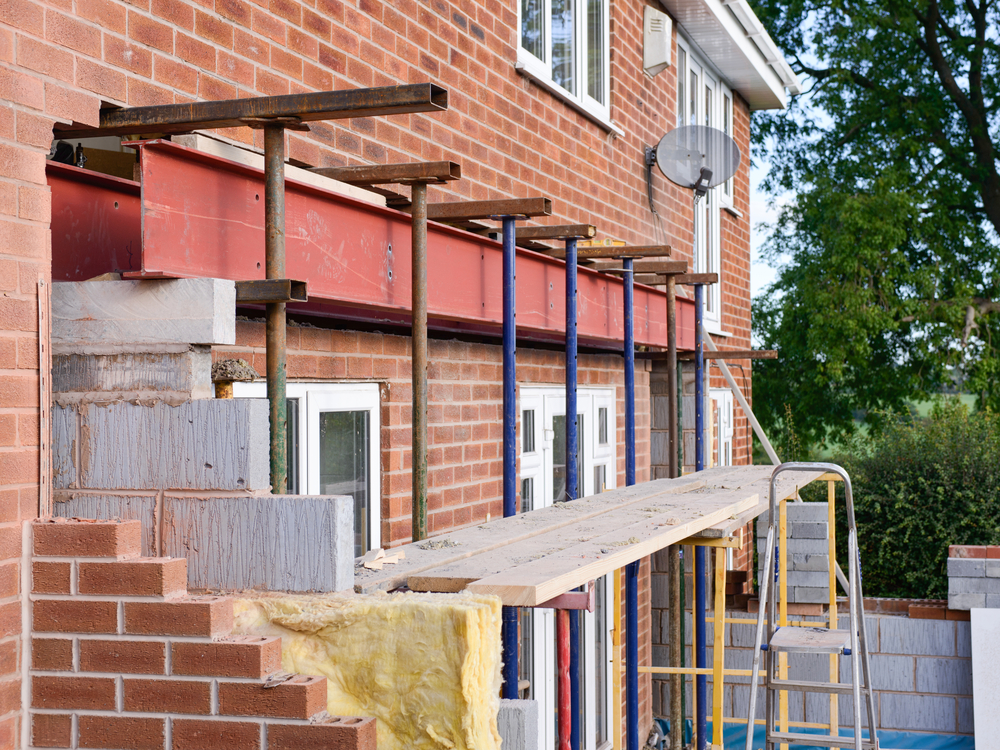Financing House Extensions in the UK

installing metal beam during house extension
Building an extension on your house is an excellent way to get extra living space, improve the aesthetics of your property and add to its value.
Getting the right finance can help expedite the process, with the best option for you depending on your circumstances.
Read on to learn more about how you can raise funds for a house extension in the UK.
Remortgaging Your Home
Remortgaging involves transferring your mortgage from one lender to another, allowing you to raise funds quickly and get a more extended repayment plan.
Provided you have enough equity and can afford repayments, you can remortgage your home to cover the costs of a house extension.
The amount of extension or work you intend to do on the property can affect a lender’s willingness to fund you.
Since you’re using your home as security, lenders want to ensure they’ll not be left with a piece of land and no house in case of repossession.
It’s crucial to ensure you borrow enough to cover the costs of the extension while remaining within your affordability to avoid losing your home.
Further Advance From Your Current Lender
A further advance involves your current mortgage provider lending you additional funds that you can use to fund an extension.
If you’ve managed your existing mortgage well and have a solid financial position, your lender may be open to increasing the borrowing on your current mortgage under the same terms.
A further advance can be a cost-effective solution to finance a house extension if the rates on your current mortgage are attractive.
Most lenders require that you repay your mortgage for at least six months before they can consider lending you more money. They may also conduct a property valuation using a house price index or send a surveyor.
A Second Charge Mortgage
Second charge mortgages are loans taken out using the equity in your home as security, and they can be alongside or in addition to your first mortgage.
They’re a common form of borrowing for house extensions. Unlike further advances, which involve changing the terms of the existing agreement, second charge mortgages are distinct loans.
As mortgageable.co.uk explains: Second charge mortgages are usually taken out with different lenders from your first mortgage at different rates and terms.
Therefore, you’ll have two monthly mortgage payments, with the first mortgage taking priority in case of defaults and repossessions.
Eligibility will be assessed the same way as the first mortgage, including your financial situation, employment, income, property type, age and credit history.
Unsecured Personal Loan
If you don’t want to borrow against your property, you can apply for an unsecured personal loan from the bank or online lenders.
Unsecured loans don’t require you to provide any of your valuable assets, like a car or home, as collateral for the loan. They’re usually suitable for small amounts and are much quicker to organise than secured loans.
However, since the lender faces a higher risk in case you default, they’ll charge higher interest rates than secured loans. The amount you borrow, your loan term and your risk profile, influenced by factors like your credit score, will determine the rate you get from the lender.
Savings
Using your savings is the cheapest way to finance a house extension. If you have some cash to spare, you’ll not need to borrow any extra money to fund your extension, meaning you’ll not pay any interest.
If you haven’t saved yet, think about how long you’ll need to accumulate the required amount and whether your savings account restricts accessing a large amount of cash.
Credit Card
If you don’t have any savings, can’t remortgage, or take out a further advance or a second charge, a credit card may be an option to finance a house extension.
Choose a 0% or low-interest credit card and ensure you can repay the whole amount in the interest-free period to avoid accruing high interest on the loan.
Using a credit card is more suited for small house extension projects.
Considerations Before Financing A House Extension
A few things to consider before arranging financing for a house extension include the following:
Planning Permission
Planning permission can create barriers when building an extension, even after taking care of financing, so it’s good to know where you stand from the beginning.
Some extensions require building regulations approval, but if your house extension falls within permitted development rights, you’ll not need planning permission.
Your permitted development rights can be strict if you live in or near protected areas, national parks, a conservation area, or a world heritage site. You can skip the planning permission process if your extension:
- Will not extend too far out, like six to eight meters from your house, depending on the property type
- Covers less than half of your land around the house as it was initially built
- Will not rise too high, where the limit is four meters for side extensions
Other rules the homeowner’s alliance set can apply, like ensuring any loft conversion doesn’t extend beyond the existing roof slope.
Steps To Finance A House Extension
Step 1: Calculate Costs and Obtain Permissions
You’ll need to know how much your house extension will cost before you get started to ensure you have a firm idea of how much to borrow or save.
It’s also wise to determine what permissions you need to start the work, especially if you’re planning a large project.
Step 2: Choose The Best Financing Option
Once you know how much you need, decide how to cover the project’s costs. You can use your savings, take out a personal unsecured loan or release some equity from your home.
Final Thoughts
A house extension can help improve the value of your property and give you more living space without moving houses.
However, it can be an expensive endeavour depending on the scale of the project, and you may need to borrow to cover the total costs.
If you plan to release equity or remortgage, ensure you consult a mortgage advisor who can help you bankroll your extension and save time and money on your project.





